| Ann. Medit. Burns Club - vol. VII - n. 4 - December 1994
EPIDEMIOLOGY OF BURNS BY FIREWORKS IN CHILDREN
Rojas Z.J., Carrasco TR, Cornejo A. E., Cortés
P. L.
COANIQUEM, Santiago, Chile
SUMMARY. An epidemiological
survey performed by COANIQUEM (Burned Children's Help Cooperation) is presented, dealing
with children burned by fireworks between 4 December 1993 and 4 January
1994 in Santiago, Chile. In this period there were 44 burned children, with
a predominance of boys (64%); the age group most affected in both sexes was 6 to
10 years. Bum accidents occurred with greatest frequency on 25 and 26 December
and I January, between 10 p.m. and midnight. Seventy per cent of the children came from
low-level socioeconomic districts in Santiago. The most frequent injury-causing agents
were firecrackers, sparklers and rockets. The upper limbs, head and neck were the most
affected parts of the body. Intermediate burns (AB) presented a frequency of 42%. This
kind of survey is not difficult to repeat in view of the high level of cooperation of
public and private hospitals. It is suggested that the domestic use of fireworks of
any kind should be prohibited and that their use in public firework displays should be
strictly regulated.
Introduction
The Burned Children's Help Corporation
(COANIQUEM), founded in Santiago de Chile in 1979, is a private non-profit welfare
institution whose main aims are to prevent the occurrence of burn accidents, to achieve
the complete rehabilitation of burned children, and to promote teaching and scientific
research in this field.
COANIQUEM has set up two Rehabilitation Centres in Chile, one in the commune of Pudahuel
in Santiago City and the other in Antofagasta, in the northern part of the country. In
these centres a professional multidisciplinary team provides burned children and their
families with integral attention.
The legal regulations in Chile regarding the manufacture, importation, distribution and
sale of fireworks (1) are not restrictive enough to prevent accidental bums. Following an
increase in the number of burns caused by fireworks during the period of the end-of-year
festivities, COANIQUEM decided to implement and develop an Epidemiological Survey
Programme regarding children burned by fireworks during a one-month period (December 1993
to January 1994). In this paper we present the epidemiological characteristics of children
affected by this kind of burn accident.
Objectives
- To identify the epidemiological variables associated with
bums by fireworks in children.
- To calculate the number of burned children in the whole
area of Santiago during the period studied.
- To identify the characteristics of the burned child: age,
sex, location of burns, burn depth, gravity, whether a direct (manipulator of fireworks)
or indirect (by-stander, passer-by or other) participant in the accident.
Materials and method
The Epidemiological Survey Programme
was carried out in Santiago de Chile between 4 December 1993 and 4 January 1994 (both
dates inclusive) with the participation of the Children's Emergency Services in Santiago,
which fall under the responsibility of the Public Health Ministry, and the most important
private hospitals with the highest concentration of children insured against accidents in
this capital city.
An instrument was designed for data collection (see Annex 1) and this was distributed
personally by COANIQUENt's chief nurse. The chief nurse at each Service was invited to
cooperate in the collection and transmission of data, and COANIQUEM received the
collaboration of every one. The data were taxed daily to COANIQUEM. A daily telephone
communication was also established with each Service in order to avoid any omissions. The
fireworks used in Chile are industrially manufactured and mostly of foreign origin.
Results
During the period in question there
were 44 notifications of children burned by fireworks. The age range was from I to 15
years. Twenty-eight of the children (63.6%) were male. The highest frequency in both sexes
was in the 6-10 year age group. All the children older than 12 years were male (Fig.
1). The highest number of burn accidents due to fireworks was recorded on 25 and 26
December and I January (Fig. 2)*
The frequency of the accidents began to increase after 8 p.m. and reached a maximum at
10 p.m., with sporadic cases until 3 a.m. (Fig 3).
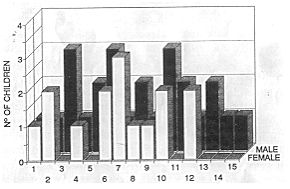 |
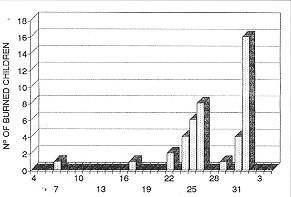 |
| Fig.1 -
Fireworks burns in children by sex and age. |
Fig. 2 - Fireworks
bums by day of occurrence. |
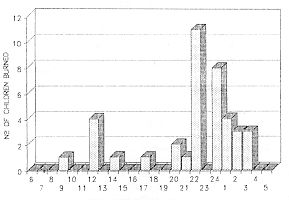 |
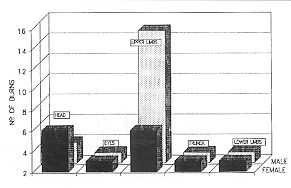 |
| Fig. 3 - Fireworks
burns by hour of occurrence. |
Fig. 4 -
Fireworks burns in children by sex and location. |
|
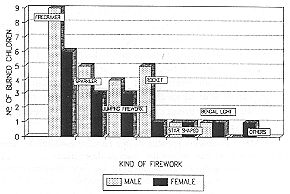 |
Fig. 5 - Burns
by sex and kind of fireworks. |
|
On the basis of the home location, it was
found that most of the affected children (70%) came from low-income socioeconomic
districts. The most affected parts of the body were the upper limbs, especially the hands
(42.9%), followed by the neck (32.7%). This group includes six children who suffered eye
burns. Approximately one-third presented burns in more than one location (Fig. 4).
Ten per cent of the children had to be hospitalized immediately. The rest were given
ambulatory treatment and advised to consult COANIQUEM.
Regarding bum depth, there was a 42.3% frequency of intermediate burns - AB in the Benaim
classification (2). There was no sex differentiation in this kind of burn. Superficial
burns (type A) accounted for 34.6% of the total, with a predominance in boys. Two-thirds
of the most serious burns (17.3%) affected boys.
The fireworks mostly used by injured children were firecrackers (36.5%), sparklers
(19.5%), jumping fireworks (17.1%) and small rockets (14.6%). There were no sex
differences as regards the kind of fireworks used, except that rockets were more used by
boys (Fig. 5). Regarding the circumstances of the accident, direct manipulation of
the firework was involved in 33% of the cases, while the children were simply watching in
the remaining 66%. It is striking that the direct manipulators of fireworks, fourteen in
all, were distributed over a wide age range (I14 years) and that two-thirds of them were
boys.
Discussion and comments
During the 32 days of epidemiological
survey of children burned by fireworks in Santiago de Chile, 44 cases were recorded in
children in the 1- 15 years age range.
Two-thirds of the bums affected males. This is a different finding from that we obtained
in bums by other agents (3). In a study of burns by fireworks during end-of-year
festivities in Denmark (4), all the burn victims were males under the age of 18 years.
Male children and male teenagers were burned by fireworks ten times more frequently than
female children and teenagers (4, 5). Superficial burns (type A) and deep burns (type B)
were more frequent in boys than in girls. In view of the finding that 70% of the cases
involved children from low socioeconomic level quarters of the city, it is confirmed that
greater educational action is necessary in such districts and that there should be an
increase in restrictive measures to prevent the sale and use of fireworks, especially
clandestine trade and manufacture in slum areas.
As to the severity of bums, 10% of the children needed hospitalization. This proportion
has been observed in burns in children by other agents (6). Other studies have shown a
hospitalization rate of 6% for this kind of injury (7).
Regarding the location of the burns, the upper limbs -as found in other studies (8, 9, 10,
11, 12) - were the most affected part of the body. In our study we also found considerable
involvement of the head and neck (30%), including the eyes. Other studies have reported a
higher frequency of thigh injuries (13) due to contact with pockets where fireworks are
carried (4).
Since 66% of the children involved in this kind of accident were merely passive
by-standers, we would emphasize that community awareness should be aroused against the use
of fireworks.
COANIQUEM advises the prohibition of the free sale and use of all kinds of fireworks by
ordinary people in the home, and proposes that firework displays should be regulated and
organized by responsible companies in order to ensure that they are properly managed with
appropriate safety measures and that each individual company is responsible for fortuitous
damage to third parties.
RESUME. Les auteurs
présentent une enquête épidémiologique conduite par COANIQUEM (Coopération et
Assistance pour les Enfants Brûlés) qui concerne les enfants atteints de brûlures
causeés par les feux d'artifice entre 4 décembre 1993 et 4 janvier 1994 à Santiago,
Chili, Le numéro des enfant brûlés était 44, avec une prédominance du sexe masculin
(64%); pour tous les deux sexes, l'âge plus intéressé était de 6 à 10 ans. Les
accidents se sont produits avec la fréquence majeure le 25 et 26 décembre et le premier
janvier, entre 10 heures du soir et minuit. Soixante-dix pour cent des enfants provenaient
des quartiers socioéconomiques bas de Santiago. Les feux d'artifice qui ont plus
fréquemment causé les brûlures étaient les pétards, les cierges magiques et les
fusées. Les parties du corps les plus atteintes étaient les membres supérieurs, la
tête et le cou. Les brûlures intermédiaires (AB) présentaient une fréquence de 42%.
Ce type d'enquête peut être répété facilement grâce à la bonne coopération des
hôpitaux publiques et privés. Les auteurs concluent en exprimant l'opinion qu'il
faudrait prohiber l'emploi domestique des feux d'artifice de tous les types et en régler
strictement l'emploi dans les exhibitions publiques.
BIBLIOGRAPHY
- C6digo de Justicia Militar: Ley de Control do Armas.
Decreto Supreme, 400. Diario Oficial, April 13 1978.
- Coiffinan F.: "Texto de Cirugfa PlAstica,
Reconstructiva y Est6tica", p.246,1986.
- Haberle G.A.: Fuegos artificiales como agentes
causales de quemaduras en nifios atendidos en COANIQUEM entre Navidad y Afio Nuevo
1990-1991, 1992-1993. Unpublished paper.
- Udesen A., Ovesen O.C.: "Bum injuries due to
fireworks during New Year Holiday. 10 year case load." Ugeskr-Laeger, Denmark, 1991.
- McCauley R.L., Steberg B.A., Rutan R.L., Hegger
J.P., Herndon D.N.: Class C firework injuries in a paediatric population. J. Trauma, 1991.
- Ministerio de Salud, Instituto Nacional de
Estadfsticas: Estadfsticas de Egresos Hospitalarios, 1991.
- Morell T., Lohmann M., Basse P.M.: "Injuries
due to fireworks".Ugeskr-Laeger, Denmark, 1992.
- Rojas Z.J., Cort6s P.L., Carrasco T.R., Cornejo
A.E.: Algunas caracterfsticas del accidente de quemadura del nifio consultante en
COANIQUEM. XVII Jornadas Nacionales de Salud Ptiblica, Escuela de Salud P6blica,
Universidad de Chile, Chile, 1993.
- Finkelstein J.L., Shartz B.S. et al.: Quemaduras en
Pediatrfa. Clin. Pediatr. NorteAm., 5: 1992.
- Ruiz B., Navarro M., Montilla B.: An epidermologic
study of burns. Annals Medit. Burns Club, 3: 170-6, 1990.
- Ruiz B., Navarro M., Montana V.: A study of burns in
children.Annals Medit. Bums Club, 4: 79-83, 199 1.
- Kon N.: Firework injuries to the hand. Ann. Chir.
Mains MembSup6r., France, 1991.
- Ergot A.F., Keeman JX: "Injuries due to
fireworks at the turn of the year 1990/1991". Ned-Tijdschr-Gebeeksd, Netherlands,
1991.
|




